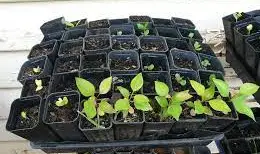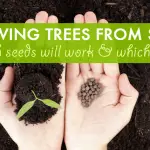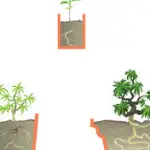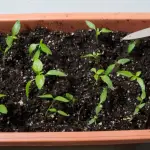
How to Grow Fruit Trees From Seed? Growing fruit trees from seed can be an exciting and productive hobby. You’ll be able to produce your own trees, which you can then plant in your garden or sell for a profit.
Growing fruit trees from seed aren’t difficult, but it does require patience and a willingness to experiment with different kinds of seeds.
Read on to learn more about growing fruit trees from seed and the right kind of seeds to use.
Growing fruit trees from seed
Growing fruit trees from seed is a popular method of growing fruit trees. Unlike grafted trees, seedlings grow much larger and are better suited for challenging growing conditions.
This is especially useful in non-irrigated areas or food forest systems. Seed planting is usually successful with some fruit trees, but it can also yield less-than-desirable results in some cases. Read on to learn more about how to grow fruit trees from seed.
The first step in growing fruit trees from seed is to prepare your seed tray. It should be shady and provide good drainage. Make sure that the seed tray is at least 10 to 12 cm deep. You should also mix germination medium for your plant.
Factors to consider
There are a number of factors to consider when growing fruit trees from seed. The first is that fruit trees can take a long time to mature. Nevertheless, this wait is worth it, since your trees will provide you with healthy food for many years. Here are three factors to consider before you plant your fruit trees.
The ideal planting site is an area with plenty of space. It must be away from power lines, sidewalks, and sewer lines. These can pose a danger, as the roots of the fruit trees can damage the pipes.
Also, the soil needs to be fertile. In addition, the tree will need plenty of sunlight.
Selecting the right tree
There are many factors to consider when selecting a tree from seed. One of the most important factors is the type of soil that is found in your area. Some soils are rocky or clay, while others are sandy or have a high pH. It is important to test the soil to determine its type.
A nursery specialist or a Cooperative Extension System office can help you determine what type of soil is appropriate for your location. You should also consider the water requirements of the tree. Some trees grow well in drought conditions, while others require lots of water.
Another important factor to consider is the age of the tree. Some trees may mature quickly, while others might require pruning. It is important to choose the right tree for the location where you intend to plant it, or you may end up spending money and time on maintenance.
Pruning
Pruning a fruit tree is an important part of growing it. This is because it reduces the height of the tree and allows sunlight to penetrate the lower branches. This is vital for proper fruit color development in some species.
Also, unpruned trees tend to have dense shoot growth, which limits air circulation and is conducive to disease.
Pruning a fruit tree can increase the size and quality of the crop. This is because pruning can create a scaffold that will support a heavy fruit load. Proper pruning techniques will ensure a bountiful crop.

Cross-pollination
When growing fruit trees from seeds, you need to understand how cross-pollination works. Different species and varieties have different needs when it comes to pollination. Some varieties require a partner with a different flowering time, and some need to be pollinated by a different variety altogether.
Pollen is transferred from one plant to another through wind, water, or other means. The pollen initiates the production of seeds on the plants, which grow into new species.
The first generation of hybrids will have characteristics of both parents, but the subsequent generations will be more variable. It may take up to five generations before the new species stabilizes. Until that time, you may not even get the desired fruit.
There are a few ways to reduce the risk of cross-pollination. One way is to grow two species of fruit trees close together in the same area.
Make sure the varieties have similar blooming dates and hardiness. Plant them as close as possible, as pollen flies best within a few yards. You should also try to plant flowers that attract bees, such as spurge.
Conclusion
To grow fruit trees from seed, you first need to know the types of trees that are appropriate for your location and climate. To help you decide, we have created a little chart that tells you about the different types of fruit trees and their climate zones.
If you live in the United States, you can expect to find a wide variety of fruit trees on your property, and many varieties are suitable to grow from seed as well as from cuttings.
Thanks for stopping by serconline.
Useful links:
https://serconline.org/knowledge-base/
https://serconline.org/product-reviews/
https://serconline.org/about-us/
https://serconline.org/contact-us/






